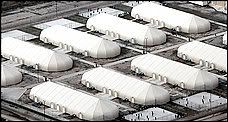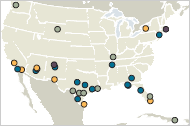In the nation’s response to the tragedy that occurred in 9/11 attacks, the border acquired new significant importance in the “war on terror.” Among the most relevant of the changes that transpired, the immigration issue is now assigned to the Department of Homeland Security. Although Mexico has no significant Islamic population and houses no known terrorist cells, the border has once again been depicted in terms of “national security.” Given that border security means stopping undocumented immigration, unfortunately, US border policies have had very real negative consequences.
 In Texas, there is an expression we like to say, “everything is big in Texas.” Within the continental United States, Texas is the biggest state by area, and the second biggest among the 50 states, only Alaska is bigger. The people of this state take pride in their bigness, from number of big oil companies to our prison system. Texas has the largest number of “immigration prisons” in the US to house the undocumented immigrants once they have been rounded up (here, here, and here); and Texas can proudly claim to the largest concentration camp in the US federal system’s archipelago of immigration prisons.
In Texas, there is an expression we like to say, “everything is big in Texas.” Within the continental United States, Texas is the biggest state by area, and the second biggest among the 50 states, only Alaska is bigger. The people of this state take pride in their bigness, from number of big oil companies to our prison system. Texas has the largest number of “immigration prisons” in the US to house the undocumented immigrants once they have been rounded up (here, here, and here); and Texas can proudly claim to the largest concentration camp in the US federal system’s archipelago of immigration prisons.
In June 2006, Willacy County commissioners entered into a two-year contract with the US Department of Homeland Security to build a futuristic cluster of tent-like domes in the Rio Grande Valley. Like a thief in the night, the prisons were quietly built in the rural town of Raymondville. The Willacy County Detention Center is one of a host of new or expanded prisons, both public and private, that ICE has commissioned for an expected rush of illegal immigrant detainees. According to the Washington Post, about 2,000 undocumented immigrants are housed within the 10 giant tent city home for weeks, months and perhaps years before they are deported back to their home countries. As the government invokes national security to sweep up and jail an unprecedented number of immigrants, the private-prison industry is booming. The $65 million camp build by Utah-based Management and Training Corporation (MTC), is a sprawling squat of inflatable domes plopped down on top of massive concrete slabs. The facility was quietly built last summer between a federal prison and a county jail where,
As the government invokes national security to sweep up and jail an unprecedented number of immigrants, the private-prison industry is booming. The $65 million camp build by Utah-based Management and Training Corporation (MTC), is a sprawling squat of inflatable domes plopped down on top of massive concrete slabs. The facility was quietly built last summer between a federal prison and a county jail where,
…illegal immigrants are confined 23 hours a day in windowless tents made of a Kevlar-like material, often with insufficient food, clothing, medical care and access to telephones. Many are transferred from the East Coast, 1,500 miles from relatives and lawyers, virtually cutting off access to counsel.
Marc J. Moore, field officer for U.S. Immigration and Customs Enforcement’s (ICE) Detention and Removal Operation, told the Brownsville Herald that the Willacy County Detention Center will be set up with 10 huge circus-like tents, surrounded by “14-foot-tall razor wire fences stand around each dome” with “two rows of razor wire fences” surrounding the 200,000-square foot prison site. The new prisons are made out of Tedlar, a “nylon material,” which they are stretched over “metal studs,” comparable to the structures that are used by the US military in Baghdad and made by Sprung Instant Structures, a company with offices in Utah. The Sprung’s structures will house about 200 beds in each tent and each tent will be divided into four 3,700-foot sections. It’s no surprise that “similar temporary buildings were used for troop recreational facilities in Iraq,” the article points out. According to OMB Watch’s searchable database of federal government spending, Strung has already won $16,864,710 in military contracts since 2000.
With an increase in stricter immigration laws and Washington’s push for tighter enforcement, these are signs to come of rural American sprawl of inflatable detentions. As Eric Schlosser mentions in his 1998 article, “The Prison-Industrial Complex” in The Atlantic Monthly:
The prison-industrial complex is not a conspiracy, guiding the nation’s criminal-justice policy behind closed doors. It is a confluence of special interests that has given prison construction in the United States a seemingly unstoppable momentum. It is composed of politicians, both liberal and conservative, who have used the fear of crime to gain votes; impoverished rural areas where prisons have become a cornerstone of economic development; private companies that regard the roughly $35 billion spent each year on corrections not as a burden on American taxpayers but as a lucrative market; and government officials whose fiefdoms have expanded along with the inmate population.
 This contemporary push to privatize corrections takes place against a socioeconomic background of serious and seemingly difficult crisis. By the fall of 2007, the administration expects that about 27,500 immigrants will be in detention each night, a gain of 6,700 over the current number in custody, according to a 2006 New York Times article. Who is going to cash in on this, and who is ultimately going to pay the price? Under the push of Bushes social Darwinism, with its “toughness” on “illegals” as its battle cry, the war profiteers in this home front is the Corrections Corporation of America (CCA), the Geo Group (formerly the Wackenhut Corrections Corporation) – the two biggest prison operators – and now Kellogg, Brown and Root, a subsidiary of Halliburton (the makers of Guantanamo Bay Detention Center) are enjoying the spoils of war. Analysts state, profit margins are higher at detention centers than prisons. According the NY Times article mentioned above:
This contemporary push to privatize corrections takes place against a socioeconomic background of serious and seemingly difficult crisis. By the fall of 2007, the administration expects that about 27,500 immigrants will be in detention each night, a gain of 6,700 over the current number in custody, according to a 2006 New York Times article. Who is going to cash in on this, and who is ultimately going to pay the price? Under the push of Bushes social Darwinism, with its “toughness” on “illegals” as its battle cry, the war profiteers in this home front is the Corrections Corporation of America (CCA), the Geo Group (formerly the Wackenhut Corrections Corporation) – the two biggest prison operators – and now Kellogg, Brown and Root, a subsidiary of Halliburton (the makers of Guantanamo Bay Detention Center) are enjoying the spoils of war. Analysts state, profit margins are higher at detention centers than prisons. According the NY Times article mentioned above:
… the Correction Corp.’s revenue from holding immigrants jumped 21 percent, to $95 million from $70 million in 2004. Geo, the second largest prison operator, received $30.6 million last year, about the same as the year before. … Wall Street analysts said that detention centers produce profit margins of more than 20 percent.
Just recently, Williamson County’s T. Don Hutto Correctional Residential Center, come under review when people found out they were housing 200 children. Hutto is operated for the government by the CCA and according to the New York Times, is “under a $2.8-million-a-month contract with Williamson County.” The Hutto Residential Center is one of two family detention centers in this country; the other is the Berks Family Shelter Care Facility in Leesport, PA.
Ever since the Hutto facility has under intense scrutiny for having a reputation as a prison that locks up children, officials invited the media to tour the place (video of tour).
In a 72-page report, “Locking Up Family Values: The Detention of Immigrant Families,” released last month by two refugee advocacy organizations, Women’s Commission for Refugee Women and Children and Lutheran Immigration and Refugee Service (LIRS), concluded that the T. Don Hutto Family Residential Center and the Berks Family Shelter Care Facility were modeled on the criminal justice system “where residents are deprived of the right to live as a family unit, denied adequate medical and mental health care, and face overly harsh disciplinary tactics.” It went to say
“Every woman we talked to in these facilities cried,” said Michelle Brané, Director, Detention and Asylum at the Women’s Commission. “Many of the children were clearly sad and depressed. Some feared separation from their parents, a common threat used to ensure that children behaved according to facility rules. Alternatives exist that are not punitive and that keep families together while also addressing the enforcement concerns of the government.”
But this is not surprising, last month, NPR reported on the findings of a new study from the inspector general of the Department of Homeland Security. According to NPR
Some non-U.S. citizens detained by the government for violating immigration laws are kept in rat-infested, cramped detention centers, fed noxious food and denied basic hygiene items such as clean socks and underpants.
Investigators found that two jails were infested with rats and roaches. The supposedly hot meals at one detention center were served cold. Detainees got food poisoning. The ventilation system didn’t work.
Some detention centers were so crowded that detainees were stacked up high, on triple bunk beds. They had to clamber up and down without ladders, because the jails refused to buy them. The inspector general reported that some detainees were injured because they fell off those bunks. And some facilities didn’t provide immigrants with clean socks and underpants, the way they are supposed to.
Don’t be misled into thinking this will end any time soon? Just recently, more than 300 immigrants were seized in a Massachusetts immigration raid. Federal immigration authorities carried out a massive raid on a New Bedford, Massachusetts, plant Tuesday morning, detaining 300 to 350 immigrant workers and charging the company’s owner and three managers with knowingly hiring undocumented workers.
 Everything is going as planned with Bush’s Endgame, where jackbooted thugs of America’s ruthlessly capturing and hauling off 400,000 Latinos “absconders” to immigration prisons. History continues repeating itself, while the capital elites enjoy the spoils of a trumped up war. Yet we continue to be a society of sleepwalkers, not wanting to care or get involved. People have to remember that violence is prompted by those who oppress, who exploit, who fail to recognize others as individuals and not by those who are oppressed, exploited, and unrecognized. It is not the helpless, subject to terror, who initiate terror, but the violent, who with their power create the concrete situation which begets the “rejects of life.” How do people come to such a pass that they can commit such atrocities against each other? Where has our empathy and kindness gone? If we cannot even show an ounce of care for them, then what has become of our humanity? So look at that little girl who is currently in the Hutto facility who is forced to wear prison garb and who will only receive one hour of fun a day and tell her that she resigned to a life of life of humiliation and wretchedness. Tell her that she is less than human and will be doomed of a life of misery, while some shut their surrounding just to continue living in their comfortable place. Tell her you would rather see her dead because her parents came her looking for a better life, if you makes you happy.
Everything is going as planned with Bush’s Endgame, where jackbooted thugs of America’s ruthlessly capturing and hauling off 400,000 Latinos “absconders” to immigration prisons. History continues repeating itself, while the capital elites enjoy the spoils of a trumped up war. Yet we continue to be a society of sleepwalkers, not wanting to care or get involved. People have to remember that violence is prompted by those who oppress, who exploit, who fail to recognize others as individuals and not by those who are oppressed, exploited, and unrecognized. It is not the helpless, subject to terror, who initiate terror, but the violent, who with their power create the concrete situation which begets the “rejects of life.” How do people come to such a pass that they can commit such atrocities against each other? Where has our empathy and kindness gone? If we cannot even show an ounce of care for them, then what has become of our humanity? So look at that little girl who is currently in the Hutto facility who is forced to wear prison garb and who will only receive one hour of fun a day and tell her that she resigned to a life of life of humiliation and wretchedness. Tell her that she is less than human and will be doomed of a life of misery, while some shut their surrounding just to continue living in their comfortable place. Tell her you would rather see her dead because her parents came her looking for a better life, if you makes you happy.
We are living in a very fractionalized and disjointed America due to the policies of our administration, but in reality we have families being broken up. I am saddened because there are children crying because they have lost their parents; there are people suffering from nativist that are hell bent on making their idea of what America should be. How many more atrocities must be committed before any of this madness is brought to an end? More importantly: How can we see another’s woe and not be in sorrow too? How can we see another’s grief and not seek ease their pain? How can we see a falling tear, and not feel for their sorrow?



and important diary. thanks. every American needs to known what is being done in this country.
Hi X…there are so many things that are just heartbreakingly wrong in this country and the horror of these ‘immigrant prisons’ with children has to be at the top of the list. The horror is doubled because way to many people just don’t care what is happening to the ‘illegals’ period…as if they somehow brought all of this misery and inhumane treatment on themselves.
I wish I could wave that fabled magic wand to put a stop to all this madness.
I was thinking about just the money mentioned in this diary and instead of it going for prisons if it had been used for humanitarian purposes and/or some type of foreign aid to Mexico to help them keep people there with better jobs and pay…
Don Hutto Detention Center was renovated for media trip.
Women are getting sexually assaulted each time they receive visitors.